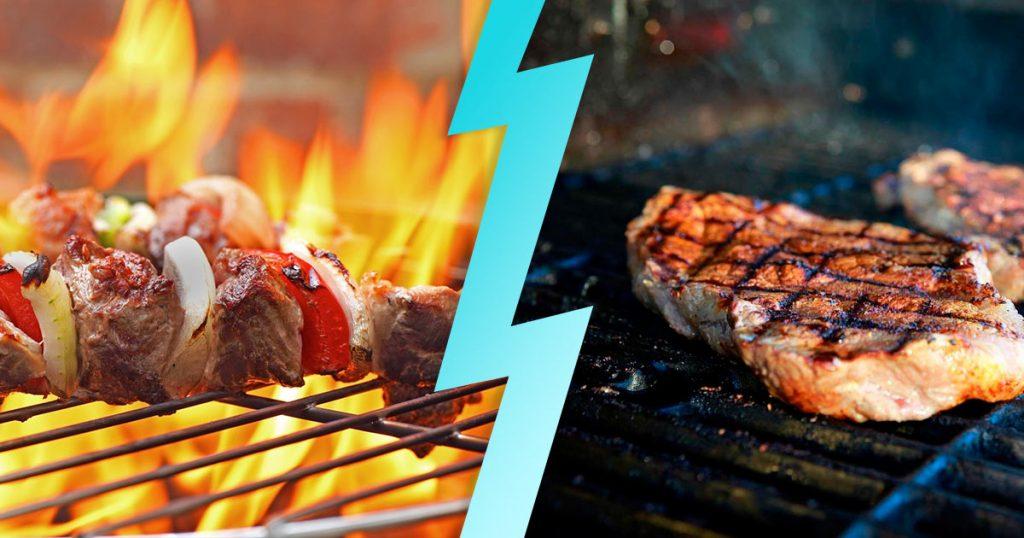A BBQ is a versatile cooking tool with three common methods: grilling (hot and fast), barbecuing (slow cooking over a low flame), and smoking (slow cooking with the use of barbecue smoke). Grilling is ideal for a variety of foods like vegetables and fruits, while barbecuing and smoking are best for meats, fish, and poultry. This blog provides a breakdown of these methods, helping you choose the best option based on your preferences and cooking needs while learning the difference between smoking, grilling, and barbecuing.
What is barbecuing?
Barbecuing is the preferred method for cooking large cuts of tough meat, such as pork shoulders, beef briskets, whole chickens, turkeys, and ribs. The slow, low heat of a barbecue is essential to achieving tenderness and rich flavor in these meats. Expert barbecue chefs take pride in the extended cooking time required for the most flavorful results. Barbecuing often involves indirect heat, with the meat positioned away from direct flames, in contrast to grilling. Charcoal or wood is commonly used as a heat source in barbecuing.
How to barbecue food:
- Decide if you want to use a charcoal or gas barbecue for cooking, each with its own benefits and flavors.
- Charcoal barbecues take a bit longer to heat up because you need to wait for the coals to cool down. But they add a nice smoky flavor to your food.
- Gas barbecues give you better control over the temperature.
- The best temperature for barbecuing is between 100 and 150°C. Place your food on the grill, not directly over the flames, using the indirect cooking method.
- Put the barbecue lid down to trap heat. This controls temperature and lets smoke circulate, adding that delicious barbecue flavor.
- Cooking a big piece of meat at low temperatures takes hours. Keep the temperature steady; if using coal, replace them during cooking to maintain the heat.
What is smoking meat?
Smoking meat on the barbecue is both an art and a science, much like barbecuing. Unlike direct-flame cooking, smoking involves using hot charcoal and slow-burning hardwood. The aromatic wood smoke envelops the meat, infusing it with flavor as it seeps into the fat, resulting in perfectly cooked meat. Smoking enhances the taste and appearance of the meat through the Maillard reaction, a complex set of chemical reactions occurring when proteins and sugars react to heat, creating new flavors, aromas, and colors.
How to smoke food:
- Achieve smoking with a charcoal barbecue, gas barbecue, or a wood pellet grill.
- Burn wood chips to make smoke; place meat away from the flame for indirect cooking, letting it soak up the smoky goodness.
- Use various wood chips for different flavors. Beech wood suits fish and poultry, while whiskey wood chips add a tasty twist to chops and beef tenderloin.
What is grilling?
Grilling, often used interchangeably with “barbecuing,” involves cooking food at high temperatures (typically around 230 – 290°C) over direct heat, usually taking less than 20 minutes. Any type of barbecue can be used for grilling. It is ideal for small cuts of food like steaks, seafood, burgers, and sausages. Grilling is also a great option for cooking vegetables and some fruits, offering a diverse range of delicious options for both vegetarian and vegan diets.
How to grill food:
- Grill using direct heat, with the flame (gas or charcoal) right under the meat.
- Put small cuts of meat and veggies in the middle of the grill, letting the flames cook them.
- Turn the food often to make sure it cooks evenly all around.
The main difference between grilling and barbecuing
The main difference between grilling and bbq-ing lies in the heat type and overall cooking duration. While barbecuing and grilling share the commonality of outdoor cooking over a heat source, they are distinct terms denoting different culinary techniques. Barbecuing is characterized by a low and slow approach, imparting a gradual tenderness to the food. On the other hand, grilling involves high and fast heat, providing a swift sear to the culinary creations.
What about smoking vs. grilling?
Smoking takes place within two distinct temperature ranges. “Cold smoking” occurs at very low heat (68°F to 176°F) for a duration ranging from 1 hour to 2 weeks, tailored to the temperature requirements and specific characteristics of the food, primarily for flavor enhancement. Additionally, smoking can be executed at low heat (126°F to 176°F) for larger foods that necessitate cooking, not solely for flavor infusion. Conversely, grilling is a globally embraced cooking method found in diverse cultures, all adhering to the common principle of preparing food over high, direct heat, typically ranging from 400°F to 550°F, for a brief period.
What makes barbecuing different from smoking?
Grilling means cooking your food slowly over a low flame, and smoking involves cooking at a leisurely pace while also using the barbecue smoke to flavor your food. When you barbecue, you’re cooking things like meats or veggies over a gentle heat, taking your time for rich flavors. Smoking takes this slow-cooking idea a step further by using the barbecue smoke to add an extra layer of delicious taste to your food. It’s like infusing your meal with a special, smoky touch that makes it stand out.
Smoking, grilling, or barbecuing – which is best?
Learn the nuanced art of each method, from slow-cooked tenderness in barbecuing to the rich flavors of smoking and the quick sear of grilling. Discover simple tips for choosing between charcoal and gas, mastering temperatures, and infusing diverse wood chip flavors into your creations. Whether you’re a seasoned pro or a backyard beginner, this guide empowers you to craft mouthwatering meals that cater to your preferences and culinary aspirations. Unleash the full potential of your barbecue and savor the satisfaction of expertly cooked dishes. Time to fire up the grill and embark on a flavor-filled journey!
